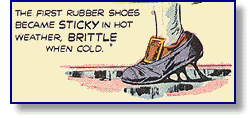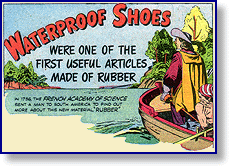 Our next stop is in Ecuador. The year is 1736. We're in the rain forest where the Tsachali
people make their home. As one would expect, these folks get the things they need
from the forest and from the rivers, things like food, clothing, shelter, and medicinal plants.
They also get something rather nifty from a tree called Hevea brasiliensis.
Hevea trees produce a liquid called rubber latex, but the Tsachali called it jepe.
This liquid provides them
with natural rubber, which is known locally as caoutchouc. This means "weeping wood"
in the Quechua language. The people here, ever resourceful, put rubber to good use as water
proof boots, and bottles, and other items.
Our next stop is in Ecuador. The year is 1736. We're in the rain forest where the Tsachali
people make their home. As one would expect, these folks get the things they need
from the forest and from the rivers, things like food, clothing, shelter, and medicinal plants.
They also get something rather nifty from a tree called Hevea brasiliensis.
Hevea trees produce a liquid called rubber latex, but the Tsachali called it jepe.
This liquid provides them
with natural rubber, which is known locally as caoutchouc. This means "weeping wood"
in the Quechua language. The people here, ever resourceful, put rubber to good use as water
proof boots, and bottles, and other items.
These folk are about to receive strange visitors paddling upriver in canoes. They wear thick,
heavy clothes and have unusually light skin. These visitors are fascinated by the rubber boots
and bottles. Don't they have things like this where they come from? Apparently not.
|
|
Cartoon of de la Condamine on expedition.
|
The visitors are from far-away France, and their leader is named Charles-Marie de
la Condamine. He is tromping around the rainforest on a scientific mission to measure
the length of one degree of longitude at the earth's equator. But he'll end up finding so much
more. The Tsachali show him how they tap the hevea rubber trees for rubber latex, and how they
dry the latex to obtain the rubber. They show him how to make objects from rubber using
molds made from plantain leaves. He is so impressed by this caoutchouc that he asks the
Tsachali to make a rubber pouch for him to protect his delicate scientific instruments.
La Condamine isn't the first visitor to the Americas who was amazed by natural rubber. Two
centuries ago the people of Mexico and the Caribbean had introduced Spanish explorers and
Conquistadors to rubber. But Condamine is the first to look at rubber scientifically.
He'll take samples back to France to study. One of his colleagues, a fellow by the name of
Fresneau will even make a stir in fashionable Paris by wearing waterproof rubber boots.

|
Cartoon of an early rubber shoe
|
Winter
But there is a problem. This rubber stuff won't work very well back in Europe. It gets much
colder in Europe than it does in the tropical rain forest, and this makes the rubber get hard
and brittle. Rubber works horribly in the snowy winter, just when it's needed most. If only
people knew just a little more about the science of natural
rubber they might be able to make it work in the cold. In time, some people would start to try to
understand rubber, but for the time being only the Tsachali and other people of Central and
South America can enjoy the benefits of rubber boots. In Europe, the only practical use for
the stuff is rubbing out pencil marks. People soon start calling it "rubber".
But almost fifty years after the Tsachali show Condamine how to use rubber, another
use for the material will be discovered by two French brothers with their heads in the clouds.
Meanwhile...
While La Condamine was traveling through South America, this was going on in the rest of the
world:
1726: In China, a massive encyclopedia is published by order of Emperor Yong Zheng. It's humble
title is Collection of Words and Pictures.
1728: In France, Charles DuFay discovers that there are two kinds of electrical charge, positive
and negative.
1732: In North America the British colony of Georgia is established by a royal charter.
For more information, at other websites...
Earthly Goods: Medicine Hunting in the Rainforest - excerpt from Christopher
Joyce's book of the same title, telling how the Tsachali, La Condamine, and others looked for
and found useful things from the plants and animals of rainforests.
Charles Marie de La Condamine - a biographical sketch from the School of
Mathematics and Statistics, University of St. Andrews, Scotland.
Methods of Tapping Rubber
Latex - natural
rubber harvesting today is done in a way very similar to the methods used by the Tsachali
centuries ago. Read about how to get rubber from a hevea tree from this site from Immune.com.
A Matter of Degrees - find out more about La Condamine's quest for the
length of a degree of latitude at the equator - a "Connections" essay by James Burke for
Scientific American.
Bibliography
1. Joyce, Christopher. Earthly Goods: Medicine Hunting in the Rainforest. Boston:
Little, Brown and Co., 1994.
Image credits
Cartoon of de la Condamine on expedition: From Wonder Book of Rubber, 1947,
copyrighted material of The BFGoodrich Company reproduced with the permission of The BFGoodrich
Company.
Cartoon of an early rubber shoe: From Wonder Book of Rubber, 1947, copyrighted material
of The BFGoodrich Company reproduced with the permission of The BFGoodrich Company.
Destination Ecuador:

Destination Ecuador:

